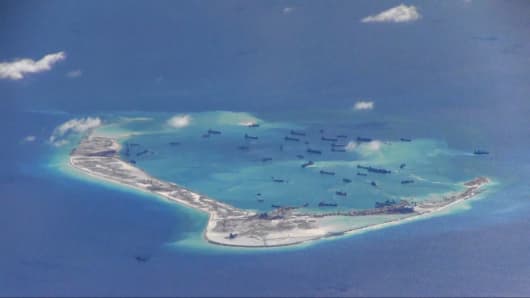US sees China boosting military presence after island-building spree
Reuters
U.S. Navy/Handout via Reuters
Chinese dredging vessels are purportedly seen in the waters around Mischief Reef in the disputed Spratly Islands in the South China Sea in this still image from video taken by a P-8A Poseidon surveillance aircraft provided by the United States Navy May 21, 2015.
China is expected to add substantial military infrastructure, including surveillance systems, to artificial islands in the South China Sea this year, giving it long-term "civil-military bases" in the contested waters, the Pentagon said on Friday.
In its annual report to Congress on China's military activities in 2015, the U.S. Defense Department estimated that China's reclamation work had added more than 3,200 acres (1,300 hectares) of land on seven features it occupied in the Spratly Islands in the space of two years.
It said China had completed its major reclamation efforts in October, switching focus to infrastructure development, including three 9,800 foot-long (3,000 meter) airstrips that can accommodate advanced fighter jets.
"Additional substantial infrastructure, including communications and surveillance systems, is expected to be built on these features in the coming year," the report said.
"China will be able to use its reclaimed features as persistent civil-military bases to enhance its presence in the South China Sea significantly."
The report comes at a time of heightened tension over maritime territories claimed by China and disputed by several Asian nations. Washington has accused Beijing of militarizing the South China Sea while Beijing, in turn, has criticized increased U.S. naval patrols and exercises in Asia.
The Pentagon report said China was focusing on developing capabilities to counter outside intervention in any conflict, but appeared to want to avoid direct confrontation with the United States in Asia, given the potential economic damage.
At the same time, "China demonstrated a willingness to tolerate higher levels of tension in the pursuit of its interests, especially in pursuit of its territorial claims," the report said.
The Pentagon disclosed on Friday that the U.S. military's top officer, Marine General Joseph Dunford, had proposed an effort to "bolster risk reduction mechanisms" to his counterpart, the Chinese Chief of the Joint Staff Department, General Fang Fenghui.
Dunford's spokesman, Captain Greg Hicks, said in a statement that both sides agreed the talks, which took place by video conference on Thursday, were a valuable way to "manage both cooperative and contentious issues, and avoid miscalculation."
The Pentagon's report cautioned that China was committed to sustaining growth in defense spending even as its economic growth cools and to pursuing objectives increasingly distant from China's shores.
Abraham Denmark, deputy assistant secretary of defense for East Asia, told a briefing that China's 2015 defense spending was higher than it publicly disclosed and had reached $180 billion, compared with an official Chinese of $144 billion.
The report pointed to China's November announcement that it was establishing a military facility in Djibouti. It said China was also expected to establish naval logistics hubs in countries with which it shares interests, including Pakistan.
The U.S report renewed accusations against China's government and military for cyber attacks against U.S. government computer systems, a charge Beijing denies. It said attacks in 2015 appeared focused on intelligence collection.
"Targeted information could inform Chinese military planners' work to build a picture of U.S. defense networks, logistics, and related military capabilities that could be exploited during a crisis," the report said.
It also cautioned that the actions and skills needed for the intrusions carried out to date "are similar to those necessary to conduct cyberattacks."

No comments:
Post a Comment
Comments always welcome!